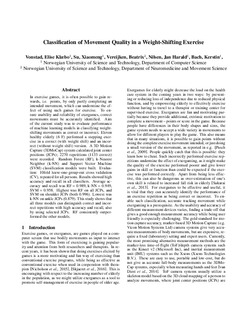Classification of movement quality in a weight-shifting exercise
Journal article, Peer reviewed
Accepted version

View/
Date
2018Metadata
Show full item recordCollections
Original version
CEUR Workshop Proceedings. 2018, 2148 27-32.Abstract
In exercise games, it is often possible to gain rewards, i.e. points, by only partly completing an intended movement, which can undermine the effect of using such games for exercise. To ensure usability and reliability of exergames, correct movements must be accurately identified. Aim of the current study was to evaluate performance of machine learning models in classifying weightshifting movements as correct or incorrect. Eleven healthy elderly (6 F) performed a stepping exercise in a correct (with weight shift) and an incorrect (without weight shift) version. A 3D Motion Capture (3DMoCap) system calculated joint center positions (JCPs); 2270 repetitions (1133 correct) were recorded. Random Forest (RF), k-Nearest Neighbor (k-NN) and Support Vector Machine (SVM) classification models were built. Evaluation: 10fold leave-one-group-out cross validation (CV), repeated for all persons. Results showed high accuracy and recall in all classifiers. Average accuracy and recall was RF = 0.989, k-NN = 0.949, SVM = 0.958. Highest was RF on all JCPs, and SVM on shoulder JCPs (both 0.996). Lowest was k-NN on ankle JCPs (0.879). This study shows that all three models can distinguish correct and incorrect repetitions with high accuracy and recall, also by using selected JCPs. RF consistently outperformed the other models.